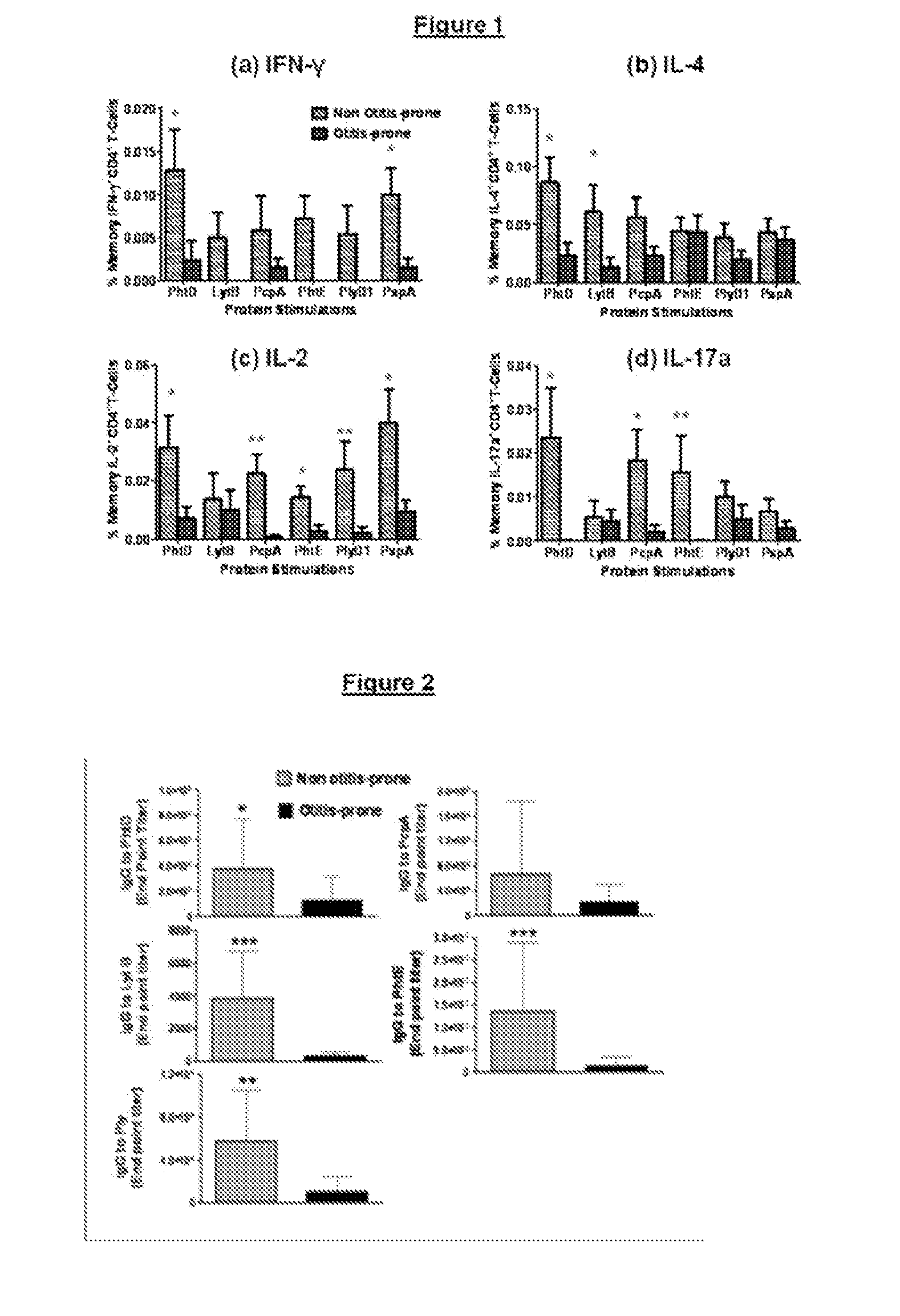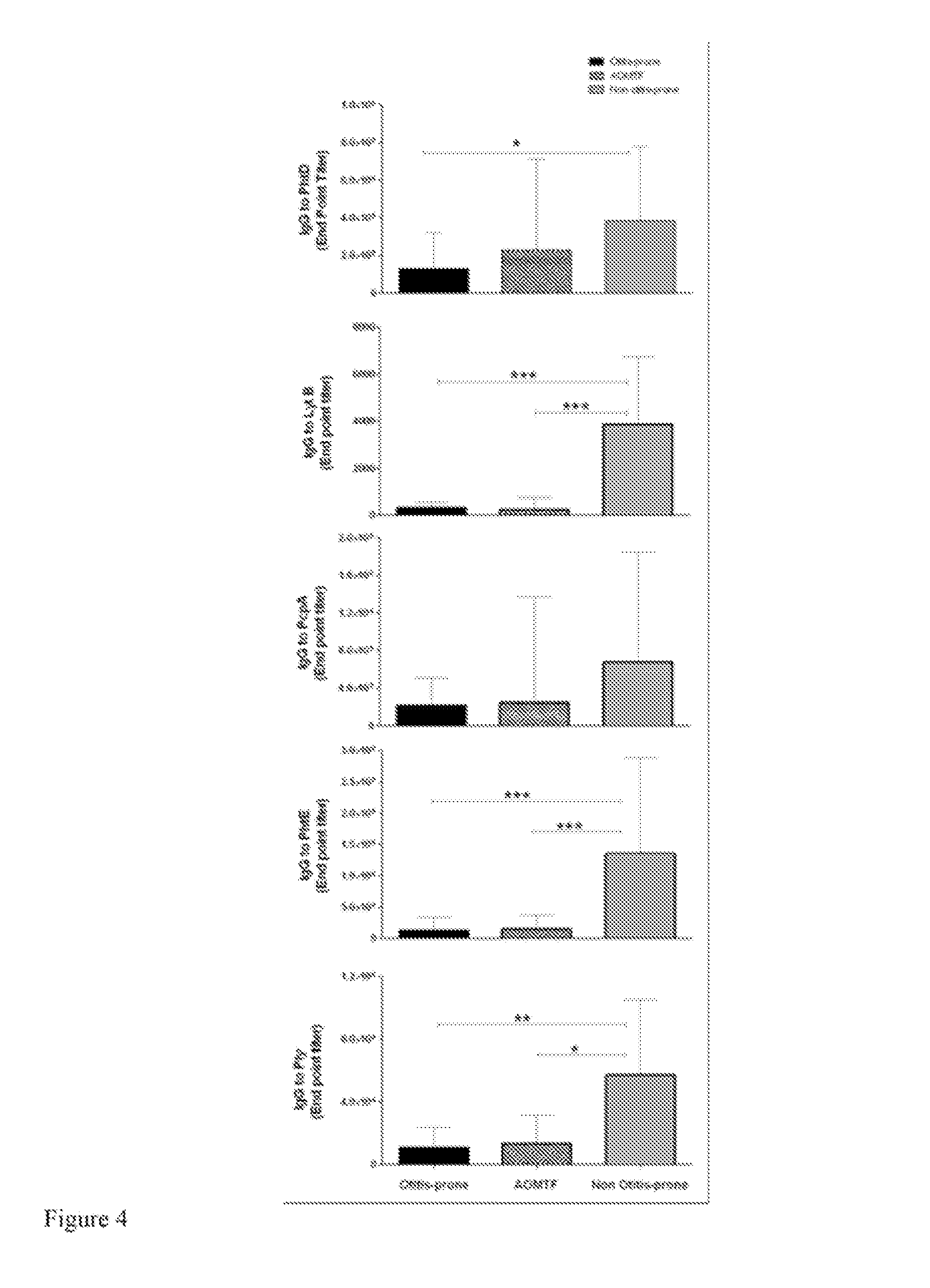Composition for Immunization Against Streptococcus Pneumoniae
a technology of streptococcus pneumoniae and composition, applied in the field of immunology, can solve the problems of large burden of deafness and other complications, excessive antibiotic consumption in children, and vaccines that are not very immunogenic in young children
- Summary
- Abstract
- Description
- Claims
- Application Information
AI Technical Summary
Benefits of technology
Problems solved by technology
Method used
Image
Examples
example 1
[0082]To evaluate the otitis-prone condition in children, using pneumococcal protein antigens, Spn specific functional memory CD4+ Th-cell subsets in the peripheral blood of a cohort of non otitis-prone and otitis-prone children were enumerated. The B-cell IgG responses were also measured to the same antigens in the serum of the children of these cohorts.
[0083]Subjects were participants from a 5-year prospective longitudinal AOM study funded by the US NIH (26). Children having three episodes of AOM within 6 months or 4 episodes within one year were considered as otitis-prone while others who had fewer episodes were placed into the non otitis-prone group. Enrolled children were from a middle class, suburban socio-demographic population in Rochester N.Y. Healthy children at age of 6 months without prior AOM were enrolled and had scrum, nasopharyngeal (NP) and oropharyngeal (OP) cultures obtained seven times, at the age 6, 9, 12, 15, 18, 24 and 30 months and both the cohorts had childr...
example 2
[0103]In this study, the development of serum IgG antibodies to PhtD, PhtE, LytB, PepA and Ply among three groups of 6 to 36 month old children with AOM were compared: 1) an otitis prone group that included children who had three or more episodes of AOM in six months or four or more episodes in a 12 month period; 2) an AOM treatment failure (AOMTF) group that included children who failed to achieve bacterial eradication and / or resolution of symptoms after at least 48 hours of appropriate antibiotic therapy (70;71) and children whose signs and symptoms of AOM returned within 14 days of completing an antibiotic treatment course; and, 3) a non-otitis prone group that included children who had only one or two episodes of AOM.
[0104]The samples collected and analyzed were obtained during the prospective study referenced in Example 1. Healthy children without prior AOM were enrolled at age 6 months and followed prospectively until 30 months of age. Scrum, NP and oropharyngeal (OP) cultures...
example 3
[0119]The circulating frequencies of Spn antigen-specific memory B-cells in sera samples obtained from a number of the otitis-prone and non-otitis prone children from the study referenced in Example 1 were assessed and compared. From the total study population of about 387 children, 22 children were studied here: 10 otitis-prone children were identified for study here (based on the availability of sufficient PBMC samples); and 12 non-otitis prone children, with 1 or 2 AOMs and of a similar age to the otitis-prone children were randomly selected to serve as controls. Clinical characteristics of the children are set out in Table 3.
[0120]Antigen-specific (PhtD, PhtE, LytB, PcpA, Ply) and total IgG secreting cells were quantified by an (in-house standardized) ELISPOT assay in which memory B-cells were stimulated in vitro to differentiate into antibody-secreting cells (ASC). Briefly, one million thawed PBMC were placed in each well of a 24-well plate containing 1 ml of complete media alo...
PUM
| Property | Measurement | Unit |
|---|---|---|
| Time | aaaaa | aaaaa |
| Time | aaaaa | aaaaa |
| Time | aaaaa | aaaaa |
Abstract
Description
Claims
Application Information
 Login to View More
Login to View More - R&D
- Intellectual Property
- Life Sciences
- Materials
- Tech Scout
- Unparalleled Data Quality
- Higher Quality Content
- 60% Fewer Hallucinations
Browse by: Latest US Patents, China's latest patents, Technical Efficacy Thesaurus, Application Domain, Technology Topic, Popular Technical Reports.
© 2025 PatSnap. All rights reserved.Legal|Privacy policy|Modern Slavery Act Transparency Statement|Sitemap|About US| Contact US: help@patsnap.com



